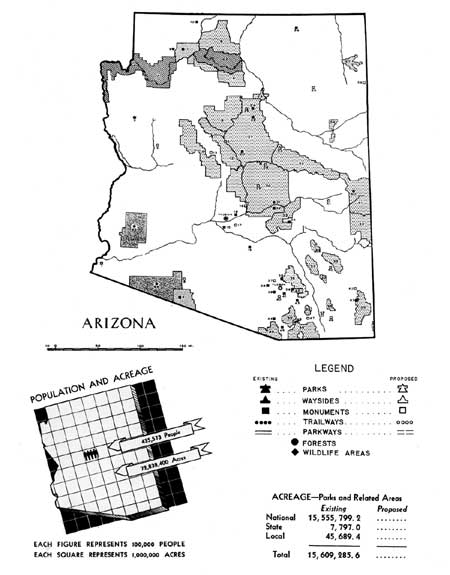|
National Park Service
A Study of the Park and Recreation Problem of the United States |

|
ARIZONA
THE POPULATION is largely in the irrigated sections, concentrated around Phoenix and Tucson, with great stretches of desert and mountain country containing few if any inhabitants. Approximately two-thirds of the State is in Federal ownership, national parks and monuments, national forests, wildlife areas, Indian lands, reclamation lands, grazing districts and unreserved public domain.
The great wealth of scenic, historic, and scientific recreation resources, including climates favorable for all types of recreational activities hoth for summer and winter, accounts for the continually increasing number of tourist and seasonal residents coming into the State.
Most of the population centers are fairly well served by municipal, metropolitan or county parks and nearby forest areas. There is no State park system and there does not appear to be a real need for one. Consideration should be given to preserving the scenic values along the highways and the provision of wayside parks for the benefit of travelers. There are many important historic and archeologic sites which should be preserved for the benefit of the State and the Nation.
Large bodies of water in this desert and semidesert country are of special recreational significance, and those such as Lake Mead and Lake Havasu are of sufficient importance because of the spectacular settings to warrant development for recreation by the Federal Government.

(click on image for an enlargement in a new window)
| FEDERAL | ||
| National park: | Existing acreage |
Proposed additions |
| 22. Grand Canyon | 645,119.5 | |
| National monuments: | ||
| 7. Organ Pipe Cactus | 330,687 | |
| 10. Pipe Spring | 40 | |
| 11. Grand Canyon | 201,291 | |
| 16. Casa Grande | 472.5 | |
| 20. Montezuma Castle | 521.4 | |
| 23. Wupatki | 35,865.3 | |
| 24. Sunset Crater | 3,040 | |
| 26. Walnut Canyon | 1,879.4 | |
| 32. Tonto | 1,120 | |
| 42. Saguaro | 63,284 | |
| 45. Tumacacori | 10 | |
| 54. Petrified Forest | 90,302.3 | |
| 56. Navajo | 360 | |
| 57. Canyon de Chelly | 83,840 | |
| 63. Chiricahua | 10694.8 | |
| Total | 823,407.7 | |
| National recreational areas: | ||
| 4. Boulder Dam | 1,142,779 | |
| National forests: | ||
| 9. Kaibab | 1,772,529 | |
| 12. Prescott | 1,265,714 | |
| 27. Coconino | 1,730,420 | |
| 30. Tonto | 2,410,636 | |
| 33. Crook | 1,422,777 | |
| 35. Coronado | 1,317,616 | |
| 52. Sitgrave | 801,735 | |
| 61. Apache | 679,432 | |
| Total | 111,400,859 | |
| National wildlife areas: | ||
| 31. Salt River Reservation | 21,120 | |
| 60. Apache Migratory Waterfowl Refuge | 2,514 | |
| 64. Cabeza Prieta Wildlife Refuge | 860,000 | |
| 65. Kofa Wildlife Refuge | 660,000 | |
| Total | 1,543,634 | |
| STATE | ||
| State parks: | ||
| 18. Papago | 1,185 | |
| 59. Saguaro | 5,920 | |
| Total | 7,105 | |
| State monuments: | ||
| 36. Fort Lowell | 12 | |
| 39. University Ruin | 40 | |
| 43. Colossal Cave | 640 | |
| Total | 692 | |
| Proposed State monuments: | ||
| 6. Joshua Tree | ||
| 8. Ajo Copper Mine | ||
| 13. Fort Whipple | ||
| 17. Maricopa Wells | ||
| 19. Fort McDowell | ||
| 21. Tuzigoot | ||
| 28. Kinishba | ||
| 29. Travertine Bridge | ||
| 37. San Jose | ||
| 40. San Xavier | ||
| 44. Tubac | ||
| 46. Camp Crittenden | ||
| 47. Guevavi | ||
| 48. Quiburi | ||
| 49. Tombstone | ||
| 50. Fort Grant | ||
| 51. Fort Apache | ||
| 53. Battle of Big Dry Wash | ||
| 55. Awatovi | ||
| 58. Fort Defiance | ||
| 62. Fort Bowie | ||
| LOCAL | ||
| County parks: | ||
| 3. Haulpai, Mohave County | 2,328.4 | |
| 38. Tucson Mountain, Pima County | 28,185 | |
| Total | 30,513.4 | |
| Proposed county park: | ||
| 1. Yuma County | ||
| County monument: | ||
| 34. Beshbagowah, Gila County | ||
| Metropolitan parks: | ||
| 15. Phoenix (4 areas) | 14,696 | |
| 41. Tucson, Randolph Park | 480 | |
| Total | 15,176 | |
| Proposed metropolitan park: | ||
| 25. Flagstaff | ||
1 Area under Federal administration June 1938.
| <<< Previous | <<< Contents>>> | Next >>> |
park-recreation-problem/arizona.htm
Last Updated: 18-May-2016